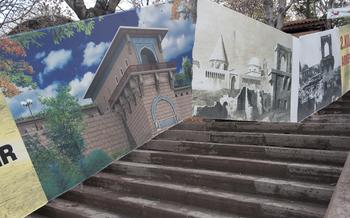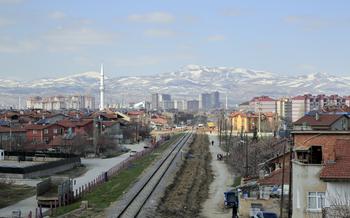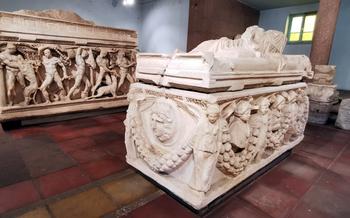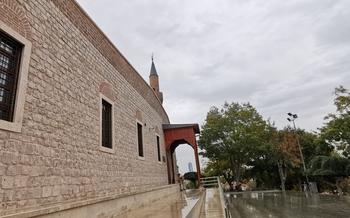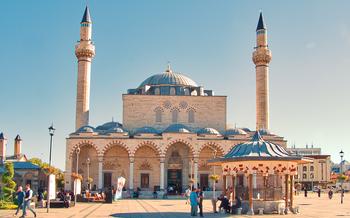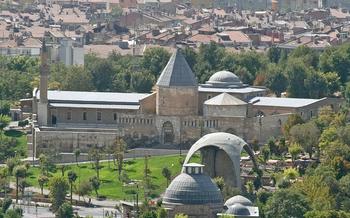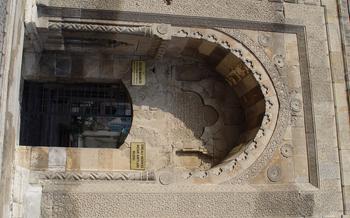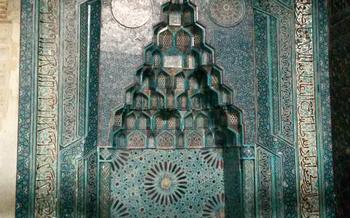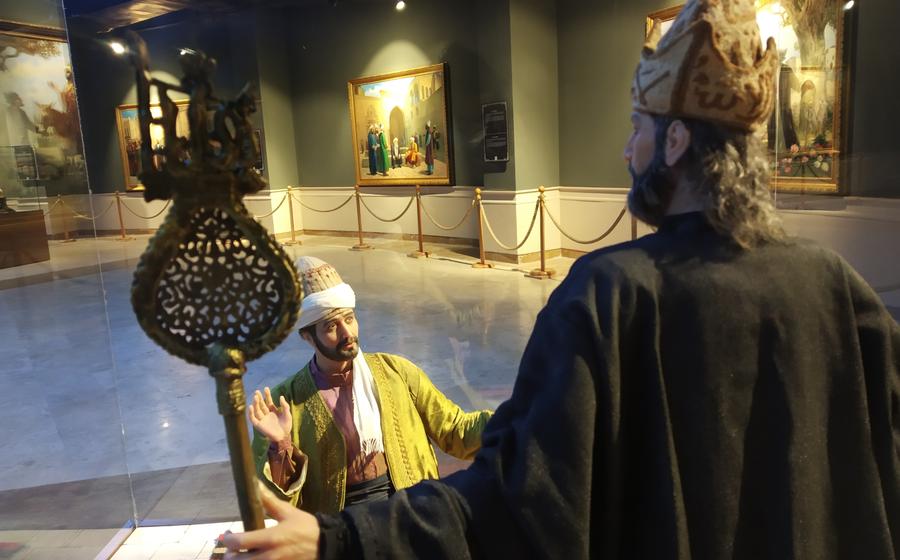
Konya Panorama Museum
- Konya Panorama Museum: A Glimpse into History
- The Battle of Konya: A Turning Point in History
- Immersive Diorama: Witnessing the Battle
- Interactive Displays: Engaging with History
- Artifacts and Relics: Exploring the Past
- Exploring the Panorama Museum:
- Educational Programs and Workshops:
- Significance of the Museum
- Visitor Tips: Making the Most of Your Visit
- Photography and Videography
- Local Cuisine and Flavors:
- Cultural Insights and Traditions:
- Nearby Attractions and Sights
- Recommended Accommodation
- Insider Tip: Unveiling the Secrets of the Konya Panorama Museum
Konya Panorama Museum: A Glimpse into History
Step into the Konya Panorama Museum, a captivating journey back in time that brings to life one of the most significant battles in Turkish history – the Battle of Konya. Located in the heart of Konya, the museum is easily accessible and invites visitors to immerse themselves in an unforgettable historical experience. Its unique features and immersive displays create a powerful narrative that transports you to the heart of the battlefield, offering a profound understanding of the events that shaped the course of history.
The Battle of Konya: A Turning Point in History
The Battle of Konya, also known as the Battle of Kösedağ, holds immense historical significance as a pivotal moment in the history of the region and beyond. Fought on June 26, 1243, near the city of Konya, the battle marked a turning point in the power dynamics of the Middle East. The clash was between the Seljuk Sultanate of Rum, led by Kayqubad I, and the Mongol Empire, under the command of Baiju and Chormaqan.
Historical accounts and narratives provide vivid descriptions of the battle's unfolding. The Seljuk forces, initially confident in their strength and numbers, underestimated the strategic prowess of the Mongols. The Mongols, with their superior military tactics and mobility, outmaneuvered and encircled the Seljuk army. The battle raged for hours, with both sides suffering heavy losses.
The outcome of the Battle of Konya was a decisive victory for the Mongols, marking a significant shift in regional power. The Seljuk Sultanate, once a dominant force in Anatolia, was severely weakened and forced to accept Mongol suzerainty. The battle had far-reaching consequences, altering the political landscape of the region and contributing to the eventual decline of the Seljuk Empire.
Immersive Diorama: Witnessing the Battle
At the heart of the Konya Panorama Museum lies an awe-inspiring diorama that transports visitors back in time to the fateful day of the Battle of Konya. This remarkable creation, spanning over 100 meters in length, offers a breathtaking panorama of the battlefield, bringing the epic clash to life with astonishing realism.
The diorama features hundreds of life-size figures meticulously crafted to depict the soldiers, horses, and commanders engaged in the fierce battle. The intricate details of their armor, weaponry, and expressions lend an air of authenticity to the scene, immersing visitors in the chaos and intensity of the conflict.
The artistic techniques employed in the creation of the diorama are nothing short of masterful. Lighting, sound effects, and panoramic painting converge to produce a multisensory experience that engages all the senses. Visitors can hear the clash of swords, the thunder of hooves, and the cries of the combatants, as if they were standing right there on the battlefield.
Standing before this immersive diorama, one cannot help but feel a profound connection to the past. It is as if time has been momentarily suspended, allowing visitors to witness the unfolding of a pivotal battle that shaped the course of history. The emotional impact of this experience is truly profound, leaving a lasting impression on all who behold it.
Interactive Displays: Engaging with History
The Konya Panorama Museum offers a range of interactive exhibits and multimedia presentations that enhance the visitor's experience and provide a deeper understanding of the Battle of Konya. Interactive touchscreens and digital displays allow visitors to explore maps, timelines, and historical documents related to the battle.
Hands-on activities, such as virtual reality simulations and interactive quizzes, engage visitors and bring the history to life. Through these interactive elements, visitors can simulate the experience of being on the battlefield, making strategic decisions, and witnessing the battle's outcome from different perspectives.
The integration of technology at the Konya Panorama Museum enhances visitor engagement and creates a memorable and immersive learning experience. These interactive displays cater to visitors of all ages, making history accessible and relatable, while fostering a sense of connection to the past.
Artifacts and Relics: Exploring the Past
The Konya Panorama Museum houses a captivating collection of artifacts and relics that offer a tangible connection to the Battle of Konya and the era in which it occurred. These artifacts, each with its own unique story to tell, provide visitors with a deeper understanding of the battle's significance and the lives of those who fought in it.
Among the most notable artifacts are weapons and armor used by the Seljuk and Mongol warriors. Swords, spears, shields, and helmets, meticulously preserved and displayed, offer a glimpse into the fierce combat that took place on the battlefield. Visitors can marvel at the intricate craftsmanship of these weapons, which were both functional and symbolic representations of military prowess.
In addition to weapons, the museum showcases personal belongings and everyday objects that provide insights into the lives of the soldiers. These items, such as cooking utensils, clothing, and jewelry, offer a human dimension to the battle, reminding visitors that behind the grand narratives of history lie the stories of individuals who experienced the conflict firsthand.
Of particular interest is a collection of manuscripts and letters that shed light on the political and diplomatic aspects of the battle. These documents reveal the strategies, alliances, and negotiations that shaped the course of the conflict, providing visitors with a deeper understanding of the complex geopolitical landscape of the era.
Through these artifacts and relics, the Konya Panorama Museum offers visitors a tangible connection to the past, allowing them to explore the Battle of Konya in a way that goes beyond the diorama and interactive displays. These historical treasures bring to life the stories of the soldiers, the strategies of the commanders, and the broader context of the battle, enriching the visitor's experience and providing a deeper appreciation for the significance of this pivotal event.
Exploring the Panorama Museum:
Whether you prefer a guided tour or the freedom of self-guided exploration, the Konya Panorama Museum offers a comprehensive experience. Guided tours provide expert insights into the history of the Battle of Konya and the significance of the museum's exhibits. For those who prefer to explore at their own pace, detailed signage and audio guides are available to enhance your understanding of the exhibits.
Allocate approximately two hours for a comprehensive visit, allowing ample time to immerse yourself in the diorama, engage with the interactive displays, and explore the collection of artifacts. The museum is wheelchair accessible, ensuring an inclusive experience for visitors with disabilities.
Educational Programs and Workshops:
The Konya Panorama Museum offers a variety of educational programs and workshops tailored for students, groups, and history enthusiasts. These programs aim to deepen understanding of the Battle of Konya, explore the historical context, and engage participants in interactive learning experiences.
Designed to complement classroom studies, the educational programs provide an immersive and hands-on approach to history. Students can participate in workshops that allow them to examine artifacts, handle replicas of medieval weapons, and engage in role-playing activities that bring the past to life.
The museum's knowledgeable staff and educators lead these programs, ensuring a comprehensive and engaging experience for participants. Through these initiatives, the Konya Panorama Museum strives to foster a deeper appreciation for history and culture, while inspiring future generations to explore the complexities of the past.
Significance of the Museum
The Konya Panorama Museum holds immense significance as a repository of historical memory and heritage. It plays a crucial role in preserving the legacy of the Battle of Konya and educating visitors about its impact on the region and beyond. The museum's immersive diorama, interactive exhibits, and collection of artifacts provide a comprehensive understanding of the battle's context, significance, and consequences. Through its educational programs and workshops, the museum actively engages students and groups in hands-on learning experiences, fostering a deeper appreciation for history and culture. As a cultural landmark in Konya, the museum serves as a testament to the city's rich past and its ongoing commitment to preserving and showcasing its historical treasures.
Visitor Tips: Making the Most of Your Visit
To make the most of your visit to the Konya Panorama Museum, here are some helpful tips:
-
Plan Your Visit: Check the museum's website for opening hours, ticket prices, and any special events or exhibitions. Plan your visit accordingly to avoid crowds and ensure a comfortable experience.
-
Guided Tours: Guided tours are available in different languages, providing insights into the museum's exhibits and the history of the Battle of Konya. Booking a guided tour is recommended for a more enriching experience.
-
Best Time to Visit: To avoid crowds and enjoy a more relaxed visit, consider visiting the museum during the weekdays. If possible, plan your visit during the shoulder season (spring or fall) for pleasant weather and fewer tourists.
-
Photography and Videography: Photography and videography are permitted inside the museum, but flash photography and tripods are not allowed. Please be respectful of other visitors and museum staff while taking photos and videos.
-
Accessibility: The Konya Panorama Museum is accessible for visitors with disabilities. Ramps, elevators, and accessible restrooms are available throughout the museum.
-
Amenities: The museum offers various amenities, including a cloakroom, gift shop, and a cafeteria. The cafeteria serves a range of snacks, beverages, and traditional Turkish cuisine, providing a convenient option for visitors to refuel during their visit.
Photography and Videography
Photography and Videography:
When visiting the Konya Panorama Museum, you might be tempted to capture the stunning diorama and exhibits through photography or videography. While this is generally permitted, there are a few guidelines to keep in mind to ensure respect for the museum's collection and the privacy of other visitors:
-
Respect the signs: The museum may have specific areas or exhibits where photography or videography is prohibited. Please pay attention to these signs and follow the instructions.
-
Be mindful of flash photography: Using flash photography can disturb other visitors and damage the delicate artifacts on display. Please consider using natural light or a low-light setting on your camera.
-
Avoid tripods and selfie sticks: Tripods and selfie sticks can obstruct the view of other visitors and pose a safety hazard in the crowded museum space. Please refrain from using these items inside the museum.
-
Capture the essence: When taking photos or videos, try to capture the essence of the diorama and exhibits without being intrusive. Focus on the details and narratives that bring the Battle of Konya to life.
-
Share responsibly: If you choose to share your photos or videos online, please be mindful of the privacy of other visitors. Avoid capturing identifiable faces or personal information without their consent.
Local Cuisine and Flavors:
Konya offers a rich and diverse culinary landscape, with a blend of traditional Turkish cuisine and regional specialties. After exploring the Konya Panorama Museum, take the opportunity to indulge in the local flavors.
-
Köfte: A must-try dish in Konya is köfte, a type of meatball made with ground beef, lamb, or a combination of both. Served with rice or bulgur, köfte is often flavored with spices and herbs, creating a mouthwatering experience.
-
Tirit: Another local delicacy is tirit, a dish made with shredded lamb or beef served over pieces of dried flatbread, known as "lavaş." The bread absorbs the juices from the meat, creating a flavorful and satisfying meal.
-
Şekerpare: For a sweet treat, try şekerpare, a traditional Turkish dessert made with semolina flour and syrup. These small, round pastries are often sprinkled with powdered sugar and are a popular choice for special occasions.
-
Mevlana Çay Bahçes: For a truly authentic experience, visit the Mevlana Çay Bahçes, a historical tea garden located near the Mevlana Museum. Enjoy a cup of Turkish tea or coffee accompanied by traditional Turkish desserts while soaking in the cultural ambiance.
Cultural Insights and Traditions:
Konya is a city steeped in history, culture, and tradition. As you explore the Konya Panorama Museum, take the opportunity to immerse yourself in the local way of life. Respect local customs and etiquette by dressing modestly and behaving respectfully in public places. Engage with the friendly locals to learn about their traditions and perspectives. Visit the nearby Mevlana Museum and Mausoleum to gain insights into the life and teachings of the renowned Sufi mystic Rumi. Konya is also famous for its traditional Turkish handicrafts, such as pottery, carpets, and metalwork. Explore the local markets and shops to find unique souvenirs and gifts that reflect the city's rich cultural heritage.
Nearby Attractions and Sights
While in Konya, embrace the opportunity to explore its rich cultural heritage and nearby attractions. Start with the Mevlana Museum, the resting place of the renowned Sufi mystic Rumi. Immerse yourself in the serene atmosphere and learn about the Mevlevi Order, known for their iconic whirling dervishes.
Next, visit the Alaeddin Mosque, a magnificent architectural marvel dating back to the 12th century. Admire its intricate tilework, soaring minarets, and the impressive prayer hall adorned with chandeliers.
For a taste of local history, explore the Konya Archaeological Museum, home to a vast collection of artifacts from various civilizations that have shaped the region. Discover ancient pottery, sculptures, and inscriptions that tell the story of Konya's past.
Venture beyond the city center to explore the Sille district, a charming village known for its unique rock-cut churches and picturesque streets. Wander through its narrow alleys and admire the well-preserved Byzantine and Ottoman architecture.
If time permits, embark on a day trip to the Göreme Valley, a UNESCO World Heritage Site famed for its breathtaking fairy chimneys, rock-hewn churches, and stunning landscapes. Marvel at the intricate frescoes and paintings that adorn the cave interiors, offering a glimpse into the region's rich history.
Recommended Accommodation
When planning your visit to the Konya Panorama Museum, choosing a suitable accommodation option is essential to make the most of your stay. Numerous hotels and guesthouses are located near the museum, catering to various budgets and preferences.
For those seeking convenience and proximity to the museum, the Konya Dedeman Hotel is an excellent choice. Just a short walk away, this modern hotel offers comfortable rooms, a swimming pool, and a fitness center.
For a more budget-friendly option, consider the Konya Kent Hotel. Located within walking distance of the museum, this hotel provides basic yet clean and comfortable accommodations.
If you prefer a luxurious experience, the Konya Hilton Convention Center is an ideal choice. This upscale hotel offers spacious rooms, a rooftop pool with panoramic city views, and various dining options.
When booking your accommodation, remember to consider factors such as the location, amenities, and budget that suit your needs. Advance reservations are recommended, especially during peak tourist seasons, to secure your preferred choice.
Insider Tip: Unveiling the Secrets of the Konya Panorama Museum
As you explore the Konya Panorama Museum, keep an eye out for the hidden gem that lies beneath your feet. Descend the stairs to discover a secret passageway leading to a small chamber. Here, you'll find a hidden diorama that offers a unique perspective on the Battle of Konya. This intimate space allows you to get up close to the intricate details of the battle scene, providing a truly immersive experience. Don't miss this hidden treasure as you journey through the museum's captivating exhibits.
